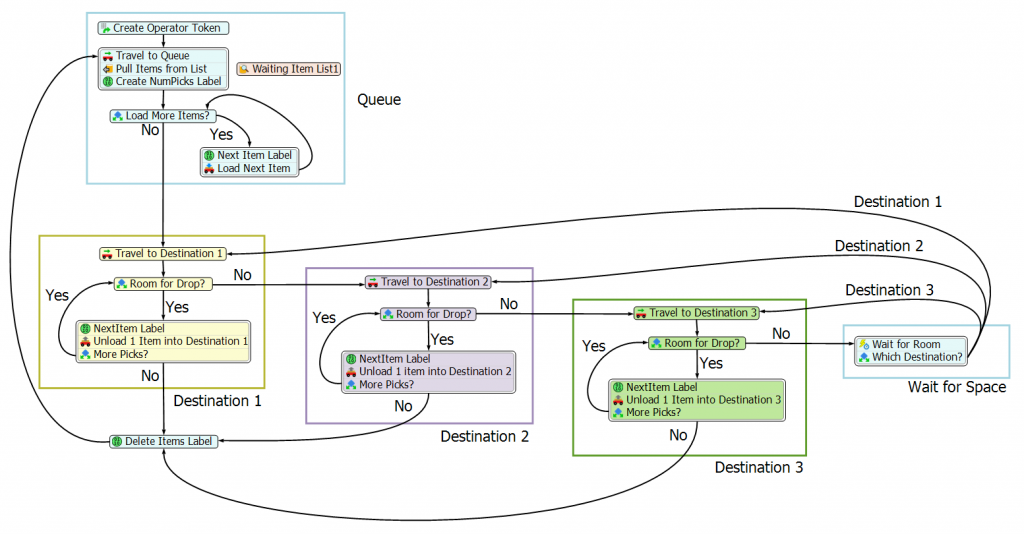WHY YOU CAN SAVE HOURS ON YOUR PROJECTS WITH FLEXSIM
Recently I got to witness a modeling miracle. Like most of our past training courses, the instructor (in this case our training manager Regan Blackett) sat down with one of the attendees to build a model he wanted to start working on. It was a manufacturing system with a few unique elements, including components shared between different facilities. The training attendee assumed it would take a few days to have a working version of the model. Ninety minutes later, and thanks mostly to a brand new tool, a sizeable portion was already finished.
вҖңWe were able to think much more abstractly from the beginning,вҖқ Regan recalled. вҖңIt let us turn a rudimentary process into a working model in a much shorter amount of time.вҖқ

Picking orders made easy thanks to Process Flow.
Back in October at our FlexSimposium, we unveiled an innovative and revolutionary way to define logic in a 3D simulation model. This tool, called Process Flow, has since become a rock star around FlexSim headquarters. ItвҖҷs made an appearance in nearly every consulting project weвҖҷve done since its earliest beta release. It punches out picking operations, crushes call centers, and puts a licking on logistical systems.
And now, with the launch of FlexSim 2016 last month, itвҖҷs ready and waiting to take your simulation experience to the next level. But can Process Flow really cut down hours from a typical simulation project? Yes, it can вҖ” and hereвҖҷs how:
1. PROCESS FLOW MAKES IT EASIER TO MODEL COMPLEX SYSTEMS
2. Anyone who has ever done a big simulation project will tell you that accurately modeling the logic of a system is the most time-consuming part. FlexSim is armed with picklist options and event triggers to ease this burden. However, many models still require a large amount of customization to make them accurate. Customization like this can often lead to lines upon lines of computer code. Process Flow tackles this problem in two ways:
It replaces nearly all computer code with a flowchart. ThatвҖҷs right, the same sort of flowcharting method that thousands of businesses rely on each day for successful projects. Using a wide array of pre-built activity blocks, you build the logic as you flowchart the system.
It allows you to stay organized. Most of us donвҖҷt think in code, but we can certainly track the steps in a process or procedure. Process Flow gives you the ability to organize your logic in a way that works best for you.
3. PROCESS FLOW LETS YOUR PROJECT SCALE AS YOU NEED IT TO
4. ItвҖҷs difficult (or even impossible) to know what shape a model might take where youвҖҷre in the early stages of an improvement project. At LM Wind Power, factory management has regular brainstorming sessions to discuss possible ideas to better their operations. Their Director of Manufacturing 2.0 Implementation, Michael Belote, explained that itвҖҷs tough to determine which ideas should be prioritized. ItвҖҷs also impractical to find the right priority by building a full simulation at this early phase. It would be nice to have a solution that could fill that gap.
вҖңProcess Flow gives you an option that is really practical and real-world, especially in factories,вҖқ Michael says. вҖңYou have the ability to get a very quick and rough, high-level idea of which brainstormed idea will provide the best output. Then you can do detailed models in a much more focused way.вҖқ

Defining logic in a simulation model is now as easy as creating a flowchart.
The best part: you can just expand your existing model in Process Flow to become that detailed model. Adjust each process in your system with more or less detail to best fit the project demands вҖ” no extra backtracking required. Just take a simple brainstorm model, flesh out a few of the finer details, and youвҖҷre already well on your way to finishing the model.
3. PROCESS FLOW KEEPS THE LOGIC IN ONE CENTRAL LOCATION
4. Dustin Derrick, a consultant here at FlexSim, tells a story about a massive, beautiful system logistics model that took him nearly a week to debug. The modelвҖҷs logic was spread across dozens of queues and processors. It was an enormous task just to track down why an operator was appearing somewhere he wasnвҖҷt supposed to be.
Modelers can avoid this problem if the logic is easier to find. In Process Flow, thatвҖҷs exactly what youвҖҷll get вҖ” a central location for the logic in your model. You can still use the best aspects of our powerful standard object library, but now you can easily create customized logic in one convenient window. Debugging is also easier than ever. As you simulate, tokens will move through your system and show you exactly what activities they are on if something goes awry.









